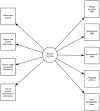Do Online Privacy Concerns Predict Selfie Behavior among Adolescents, Young Adults and Adults?
- PMID: 28588530
- PMCID: PMC5440591
- DOI: 10.3389/fpsyg.2017.00815
Do Online Privacy Concerns Predict Selfie Behavior among Adolescents, Young Adults and Adults?
Abstract
Selfies, or self-portraits, are often taken and shared on social media for online self-presentation reasons, which are considered essential for the psychosocial development and well-being of people in today's culture. Despite the growing popularity and widespread sharing of selfies in the online space, little is known about how privacy concerns moderate selfie behavior. In addition to this, it is also not known whether privacy concerns across age and gender groups influence selfie behavior. To address this timely issue, a survey assessing common selfie behaviors, that is, frequency of taking (individual and group selfies), editing (cropping and filtering), and posting selfies online, and social media privacy concerns (over personal data being accessed and misused by third parties) was conducted. The web-survey was administered to 3,763 Norwegian social media users, ranging from 13 to 50 years, with a preponderance of women (n = 2,509, 66.7%). The present study investigated the impact of privacy concerns on selfie behaviors across gender and age groups (adolescent, young adult, and adult) by use of the structural equation modeling approach. The results suggest that young adults have greater privacy concerns compared to adolescents and adults. Females have greater privacy concerns than males. Greater privacy concerns among female social media users were linked to lower engagement in selfie behavior, but privacy concerns did not influence selfie behavior in the case of male adolescents and young adults. Overall, privacy concerns were more consistently and inversely related to selfie behavior (taking and posting) among females than males. The study results have theoretical as well as practical implications for both researchers and policy makers.
Keywords: age; gender; privacy; self-presentation and selfie behavior; social media.
Figures
Similar articles
-
How HEXACO Personality Traits Predict Different Selfie-Posting Behaviors among Adolescents and Young Adults.Front Psychol. 2017 Jan 10;7:2080. doi: 10.3389/fpsyg.2016.02080. eCollection 2016. Front Psychol. 2017. PMID: 28119662 Free PMC article.
-
Selfie Expectancies Among Adolescents: Construction and Validation of an Instrument to Assess Expectancies Toward Selfies Among Boys and Girls.Front Psychol. 2018 May 29;9:839. doi: 10.3389/fpsyg.2018.00839. eCollection 2018. Front Psychol. 2018. PMID: 29896145 Free PMC article.
-
How do "selfies" impact adolescents' well-being and body confidence? A narrative review.Psychol Res Behav Manag. 2019 Jul 9;12:513-521. doi: 10.2147/PRBM.S177834. eCollection 2019. Psychol Res Behav Manag. 2019. PMID: 31372071 Free PMC article.
-
A scoping literature review of the associations between highly visual social media use and eating disorders and disordered eating: a changing landscape.J Eat Disord. 2023 Sep 26;11(1):170. doi: 10.1186/s40337-023-00898-6. J Eat Disord. 2023. PMID: 37752611 Free PMC article. Review.
-
Hot Topics in Social Media and Reproductive Health.J Pediatr Adolesc Gynecol. 2020 Dec;33(6):619-622. doi: 10.1016/j.jpag.2020.06.016. Epub 2020 Jun 26. J Pediatr Adolesc Gynecol. 2020. PMID: 32599170 Review.
Cited by
-
Unpacking the Potential Influence of Life Satisfaction on Network Heterogeneity, Emotional Exhaustion and Mobile App Fatigue: A Stressor-Strain-Outcome Approach.Int J Environ Res Public Health. 2023 Feb 16;20(4):3500. doi: 10.3390/ijerph20043500. Int J Environ Res Public Health. 2023. PMID: 36834196 Free PMC article.
-
Privacy concerns toward short-form video platforms: Scale development and validation.Front Psychol. 2022 Aug 5;13:954964. doi: 10.3389/fpsyg.2022.954964. eCollection 2022. Front Psychol. 2022. PMID: 35992413 Free PMC article.
-
Privacy Concerns and Information Sharing: The Perspective of the U-Shaped Curve.Front Psychol. 2022 May 10;13:771278. doi: 10.3389/fpsyg.2022.771278. eCollection 2022. Front Psychol. 2022. PMID: 35619791 Free PMC article.
-
Love in the Time of Corona: Predicting Willingness to Engage in Sexting During the First COVID-19-Related Lockdown.Arch Sex Behav. 2022 Jan;51(1):157-168. doi: 10.1007/s10508-022-02292-w. Epub 2022 Feb 7. Arch Sex Behav. 2022. PMID: 35132483 Free PMC article.
-
Selfie-engagement on social media: Pathological narcissism, positive expectation, and body objectification - Which is more influential?Addict Behav Rep. 2020 Feb 19;11:100263. doi: 10.1016/j.abrep.2020.100263. eCollection 2020 Jun. Addict Behav Rep. 2020. PMID: 32467852 Free PMC article.
References
-
- Albury K. (2015). Selfies, sexts, and sneaky hats: young people’s understandings of gendered practices of self-representation. Int. J. Commun. 9 1734–1745.
-
- Anderson E. (1999). Code of the Street: Decency, Violence, and the Moral Life of the Inner City. New York, NY: W. W. Norton & Company.
-
- Barnes S. B. (2006). A privacy paradox: social networking in the United States. First Monday 11
-
- Boyd D. (2008). Taken Out of context: American Teen Sociality in Networked Publics. Ph.D. dissertation, University of California-Berkeley; Berkeley, CA.
LinkOut - more resources
Full Text Sources
Other Literature Sources




